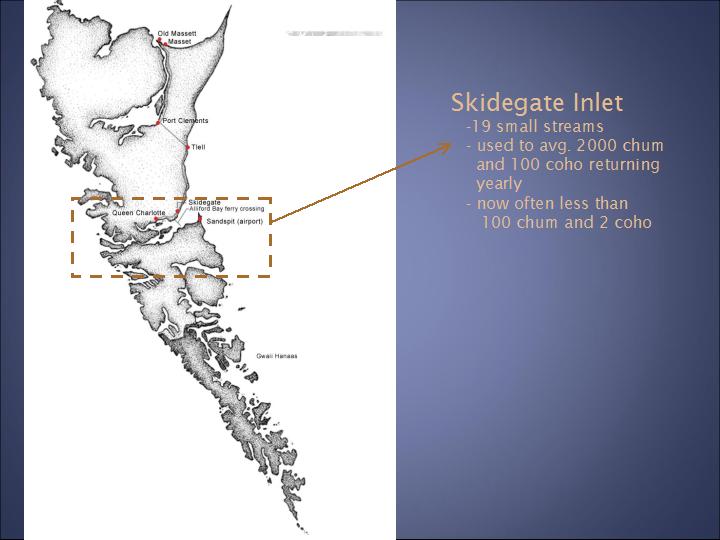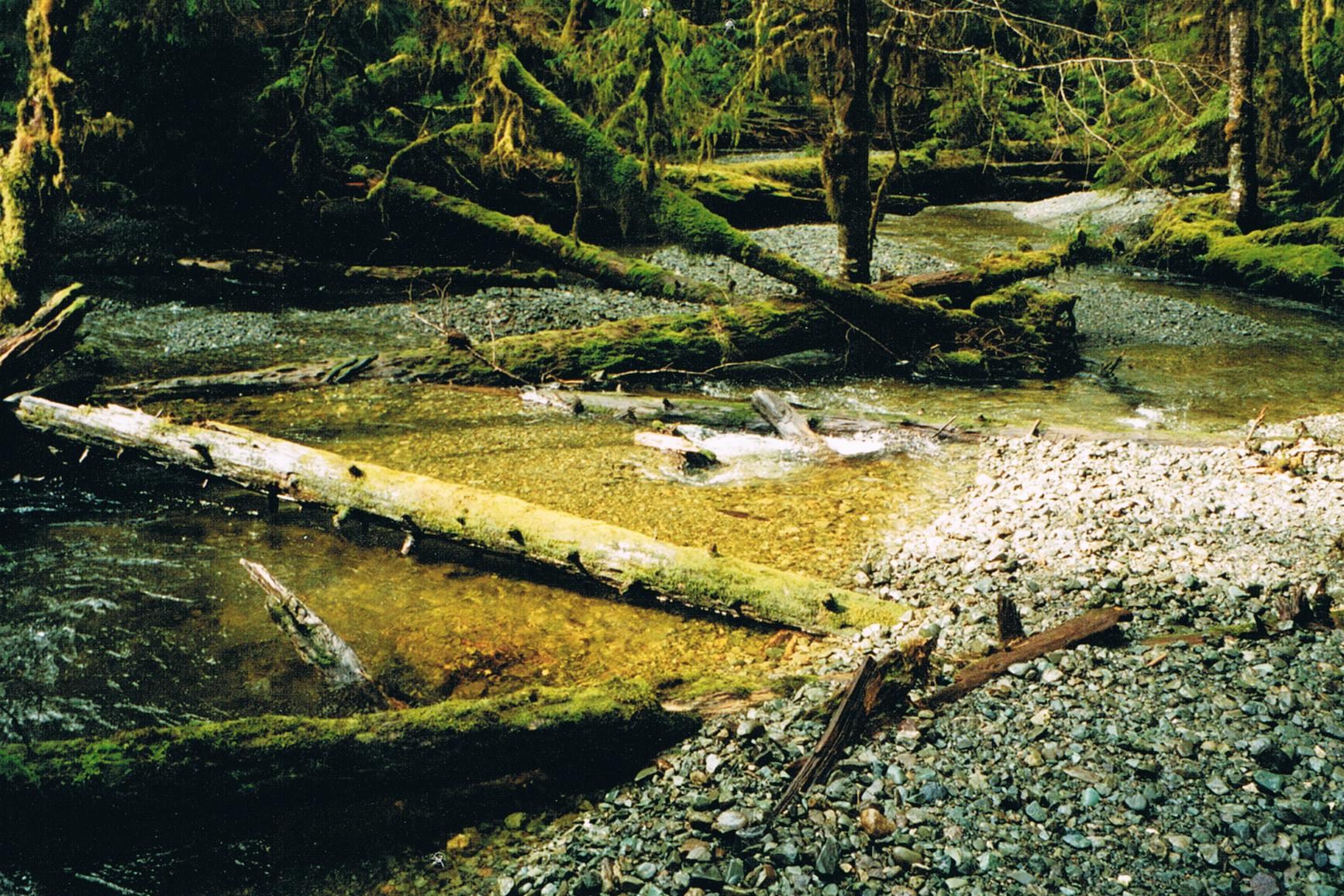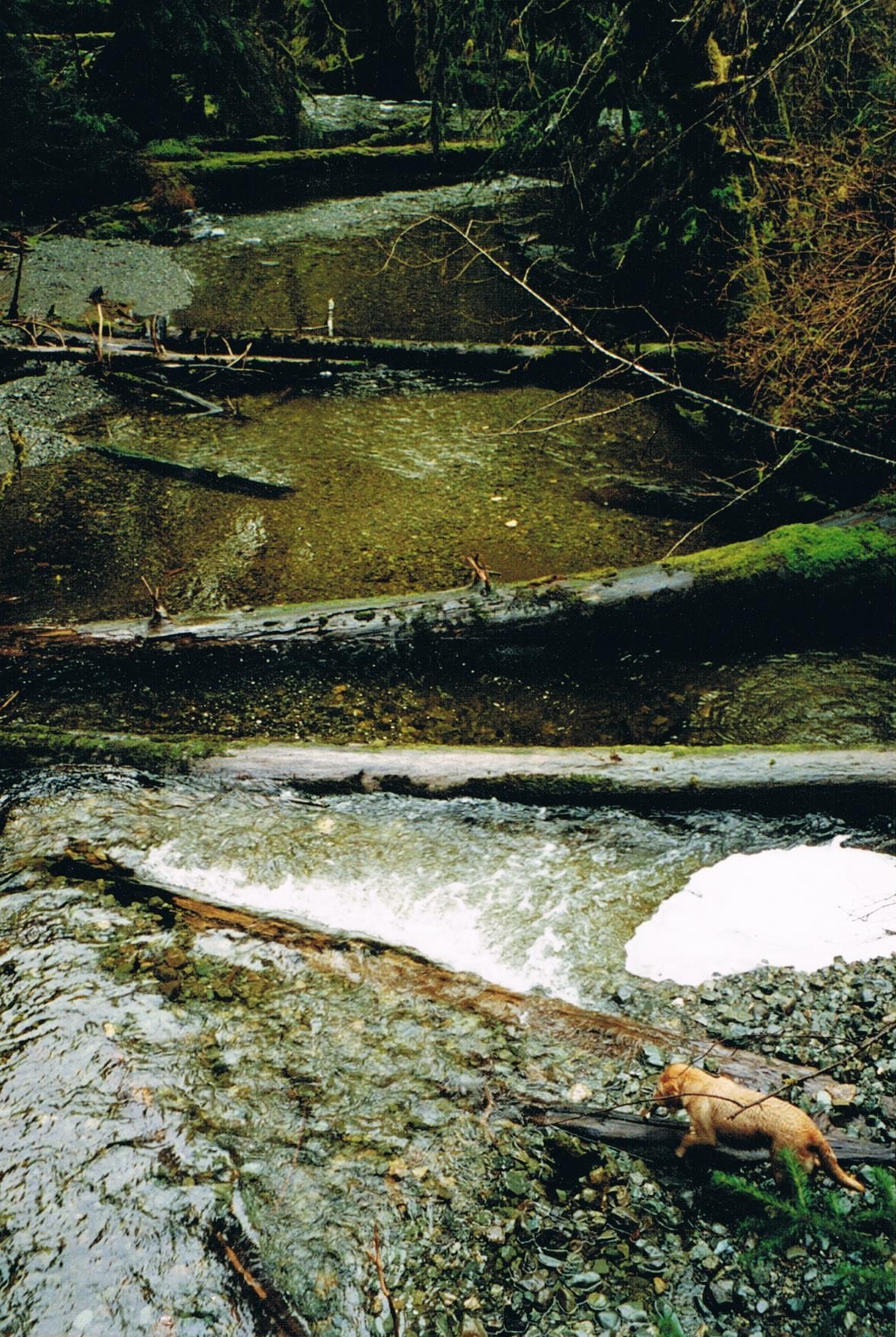What is your salmon story?
There are thousands of people throughout British Columbia that are involved with wild salmon – The Gumboot Army as some folks have labeled them. There are thousands and thousands more throughout the range of Pacific salmon circling the northern Pacific Rim.
Prior to setting out on The Wild Salmon Cycle I worked for one of these small community groups dedicated to wild salmon – the Hecate Strait Streamkeepers. This is a fantastic organization on Haida Gwaii (off the coast of British Columbia, Canada) comprised of commercial fishermen, former (and sometimes contracted) Fisheries and Oceans staff, and various concerned local folks.
Through the late 1990s I worked for the Streamkeepers and we focussed on nineteen small streams located around Skidegate Inlet – the narrow body of water separating the two main islands of Haida Gwaii.

The bulk of these small streams have seen over 80% of their watershed area logged through the 1960s, 70s, and 80s. There have also been intensive commercial fisheries in the inlet through that same time (for example the standard catch 80% of the salmon runs and expect 20% to reproduce in perpetuity).
Various estimates and stream walks counting spawning salmon over the last 30-40 years suggest that each of these small streams once had chum salmon returns averaging approximately 1000-1200 spawners each year and approximately 100-200 coho spawners each year (at least in recent memory).
In the years that I worked with the organization, those streams were lucky to see 100-200 chum and 2-4 coho.
The Streamkeepers had successfully employed a small volunteer run hatchery as stream life support systems. Every year, volunteers would catch spawning adults from a relatively healthy stream that had also been saved by “enhancement” (hatcheries in other words) – fertilize the eggs in large buckets, incubate the eggs in a small hatchery until they became young salmon fry, then release the salmon fry into the streams needing life support.
The goals was to limit this practice of life support to 4-8 years or approximately two life cycles – then allow the stream and salmon populations to recover on their own.
In complimenting the life support system, the Streamkeepers began an ambitious program of trying to rehabilitate salmon habitat in the nineteen severely disturbed streams. I do not call it restoration – because that suggests returning to a previous state. These streams will need about 600-800 years to restore themselves as that’s how long it will take for the massive trees that once lined the stream banks to grow back. These trees hold the stream in place and when they fall into the stream they provide all the habitat that every salmon (and other fish) need.

Jiinanga (sometimes referred to as Government Creek) on Haida Gwaii – the last unlogged watershed in Skidegate Inlet.
The trees also hold the hillsides upstream in place so that landslides, debris torrents, and whatever else don’t join forces with gravity and come plowing their way downstream. Those large trees on the hillsides are also amazing sponges assisting in holding the huge coastal rainfalls and provide shade that regulate the speed of melting snow.
 Jiinanga – old growth stream
Jiinanga – old growth stream
The Streamkeepers utilize a strategy of attempting to disturb streams as little as possible when rehabilitating. One could suggest an analogy: it’s the difference between doing arthroscopic knee surgery as opposed to reconstructive knee; reconstructive sometimes doing more damage than good. There are many practitioners in stream rehabilitation that like big machinery, big budgets, big blueprints, and professional engineers. The Streamkeepers try to keep things to chainsaws and hand tools – and an incremental process year-by-year, carried out by people who have observed these streams for decades, and who monitor and evaluate the work throughout the year.
This work was by far some of the most satisfying and enjoyable of my life. Day in and day out I was walking streams, looking at small things that our crew could do in-stream to make big differences, and talking salmon and salmon habitat all day long. I grew up on rivers and streams – and spent the majority of my pre-teen and teen weekends and summers fishing on some Haida Gwaii stream, or out on the chuck (the ocean).
During the late 1990s, funding for this type of work was popular. Fisheries and Oceans Canada had a 5-year program called the Habitat Restoration and Salmon Enhancement Program (HRSEP). This program pumped hundreds of thousands of dollars into small community groups throughout BC and the Yukon. There was also the Province of BC’s Fisheries Renewal program also pumping money into these programs.
These types of funding programs are helpful and damaging – they assisted in paying my bills. However, they are generally incredibly short-sighted. For example, the Hecate Strait Streamkeepers went from a tiny volunteer-run organization with bits and pieces of funding to an organization with an annual budget sometimes between $300,000 and $400,000 and a summer crew of 6-10 people. Now the organization (as so many others around B.C.) is back down to small budgets and some specific projects for other government agencies.
Some good work was done, yet who is going to monitor all these projects over the long-term and continue to improve salmon habitat and the various projects?
How is a jolt of funding for one life cycle of salmon going to make much of a difference over the next 10 years, 20 years, 30 years?
Those answers are the thousands of people and organizations out there continuing the work. It’s those stories that I love to hear. It’s those stories that I heard about and read about as I rode the range of Pacific salmon in North America. I would like to hear more of those stories – and with permission document and tell those stories to others.
I would like to tell those stories in a format such as this blog, or other website – and I would like to tell those stories in a hard copy format. By highlighting these stories I hope to provide a network and a forum for the stories to be shared, read, appreciated – and maybe even to inspire. It’s very easy to get frustrated – and even apathetic – watching bureaucratic wrangling, bumpf-filled debating, and sandbox-like bickering between one sides science and another sides science. I find it much more refreshing to hear about folks putting on their gumboots (or waders, or shorts in the case of one of my former colleagues) and getting their hands wet and dirty.
Please email me a story, or contact information, or make comments on this blog – or come and find me this spring and summer as I set out to market some books and meet people.I will use this blog to update where I intend to be, and when. Let me know if I should come to your place.
dloewen


Hello,
My sister gave me your URL,
I live in a forest too on the banks of almost extinct salmon spawning ground.
I am an artist and I need a picture of a sockeye skeleton. Have you seen one or know where I could get one? Not to photocopy. I need a reference for drawing. I will read your blog – looks interesting –
many thanks,
Robin
Robin. I’ll check around. I think i have a photo of a chum skeleton somewhere in my photos. Also check out my “about header photo” page. There is a link to Andrew Wright’s stunning webpage and books:
The beautiful header photo on this website is from one of his books. There’s a contact form on his web page and he’s a great fellow to chat with.
thanks for the comment and thanks to your sister for spreading the word. Would love to see the drawing, or others, if you care to share them….
take care,
dl
Great Wild Salmon stuff, wish I had some here ! I am here on the North Arm of the Fraser River in Vancouver and every time it rains over 1 inch, “50 Plus Big pipes” puke out everthing you could think about directly into the river ! One real nasty pipe The “Bentley Street Outfall” gets its river screen plugged up with oily rags from some industry that changes oil in big trucks ! Naughty, Naughty now do not do that again ! Forgot to mention the “Bentley Street and “The river outfall from Hell ” named for a lumber Baron of the past , you know the guy who logged the hell out of the Q. C. s then moved South and buggered up the Fraser River with his P. C. Ps and , anti sapstain chemicals ! Nice Guy and when the mill closed down and layed off the big crews, they left this Filled in “Blind Ended historic slough” that was once Fraser Sockeye Smolt Habitat ! Yes there is more big slaps in the F. R. Wild Sockeye Salmons face,s ! The big mill and its managers tried to restore some replacement Sockeye habitat in a waste dump on a river Island , ya you got it right, no way could it work ! too bad for the F. R. Juvenile Socks! See you later , not you ! the sockeye of course ! Terry “From the North Arm of the Fraser river”
Terry
So so tragic. Please send this comment to the cohencommission.ca in an e-mail. They will publish it on their website. It needs to be seen by the lawyers and the Commissioner. People will make comments because this is something that needs to be know, understood and dealt with.
thanks
Priscilla
Terry
So so tragic. Please send this comment to in an e-mail. They will publish it on their website. It needs to be seen by the lawyers and the Commissioner. People will make comments because this is something that needs to be known, understood and dealt with.
thanks
Priscilla
Hi David,
re: Robin
I don’t think Robin or I knew about seeing an answer to our comments when she first requested the picture. Internet blogging was new to us. Thanks for the link- I’ll be sure Robin gets it. You can see some of her work on the video of our salmon walk. Her pictures are 3 dimensional salmon forms – in the background there are pieces of newspaper stories about salmon.
Her art was displayed in the first weekend in June. I walked by one of her pictures called “the last salmon” – It just all welled up and I cried. She sold one picture and apparently another will be posted on an “eco” Internet website (don’t know the details – Gord will take the picture)
I know she would be very happy to show you her salmon art.
regards,
priscilla PS you don’t have to post this if you don’t want
here is a link sent to me by email that tells a salmon story: